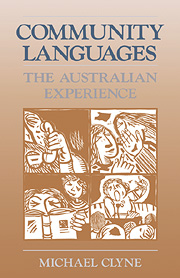Book contents
- Frontmatter
- Contents
- List of tables
- List of graphs
- Map of Australia
- Preface
- 1 Australia between monolingualism and multilingualism
- 2 Distribution and maintenance of community languages in Australia
- 3 The use of community languages in Australia
- 4 Structural and typological aspects of community languages
- 5 The formulation and implementation of language policies
- Appendix
- Glossary
- Bibliography
- Index
5 - The formulation and implementation of language policies
Published online by Cambridge University Press: 09 November 2009
- Frontmatter
- Contents
- List of tables
- List of graphs
- Map of Australia
- Preface
- 1 Australia between monolingualism and multilingualism
- 2 Distribution and maintenance of community languages in Australia
- 3 The use of community languages in Australia
- 4 Structural and typological aspects of community languages
- 5 The formulation and implementation of language policies
- Appendix
- Glossary
- Bibliography
- Index
Summary
In Chapter 1, I showed how, from the early 1970s, Australia had adopted positive attitudes and policies towards immigrant languages and cultures. Drawing on information in earlier chapters, I shall outline the development of co-ordinated language policies at the federal and state levels. It is not my intention to discuss in detail the events leading to the National Policy on Languages. These are dealt with comprehensively in Ozolins (1988). An attempt will be made, however, to compare the present state of implementation with the formulated policies. The question will be addressed if other countries have anything to learn from Australia's language policy experience.
THE PUSH FOR LANGUAGE-RELATED POLICIES
The push for a National Language Policy came in two phases — the first in favour of policies on language-related issues and the second explicitly for a National Language Policy. There was, of course, considerable overlap between them. They are part of the change from assimilation to multiculturalism policy.
The language-related policy suggestions came through demands to end discrimination against ethnic minorities in access to facilities and information and also for the education system(s) and the media to take into account the multicultural composition of the population. The first concerns only non-English speakers. Examples of demands relating to language are:
the employment of interpreters in offices, hospitals, law courts, prisons and schools and interpreter facilities at driving tests;
improved facilities for ESL teaching;
the introduction of maintenance-oriented community language programs in primary, secondary and tertiary education;
the introduction of bilingual education, where appropriate;
the establishment of an ethnic radio station.
- Type
- Chapter
- Information
- Community LanguagesThe Australian Experience, pp. 213 - 246Publisher: Cambridge University PressPrint publication year: 1991

